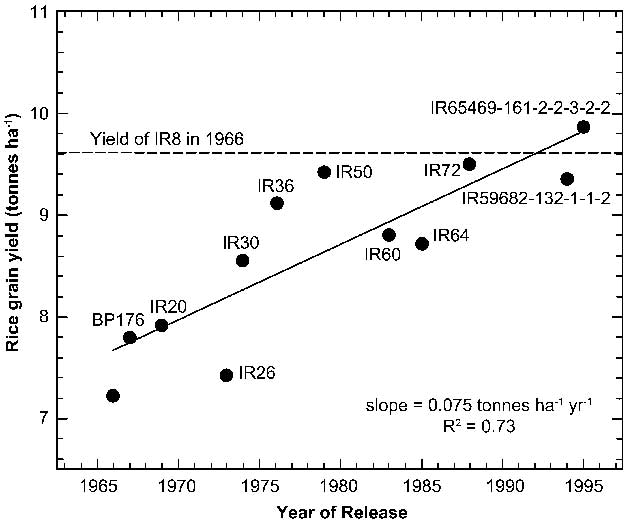
Figure 3-5. Current yield potential of rice modern varieties (MVs) as a function of year of release. Source: Cassman et al., 2003, derived from Peng et al., 1999.
Note: Dashed line indicates the yield potential of IR8 when it was released in 1966. Graphic illustrates the importance of "maintenance breeding" and of stagnating yield potential
understanding of marginal environments, such as those with acid soils or heat/drought stress (Reynolds and Borlaug, 2006). In maize, about 50% of the increase in yield attributed to genetic gain is due to improvements in stress tolerance (Tollenaur and Wu, 1999), which has contributed to maize expansion in more marginal environments.
Crop improvement has reduced genetic diversity, but current breeding strategies are tackling this problem.
Goals |
Certainty |
Range of Impacts |
Scale |
Specificity |
In Asia, MVs account for >75% area for wheat and rice and village level studies in Nepal have shown incidences of a single wheat MV, CH45, occupying 96% of the area (Evenson and Gollin, 2003b; Witcombe et al., 2001). Elsewhere, notably in Africa and CWANA, MVs occupy smaller proportions and many more TVs can be found (Evenson and Gollin, 2003b). The loss of genetic diversity due to the widespread adoption of MVs has resulted in negative environmental impacts (Evenson and Gollin, 2003ab): reducing the availability of genes for future crop improvement, creating the possibility for inbreeding depression (with negative impacts on production), reducing species ability to adapt to change (eg. climate change) and evolving resistance to new pest and disease outbreaks. However, this is disputed (Maredia and Pingali, 2001). Genetic diversity can vary both temporally and spatially, and both have to be taken into account in assessing impacts on diversity. The rapid replacement of old varieties with newer ones has increased the temporal diversity in Mexico and Pakistan, especially when current breeding programs increasingly use more genetically diverse traditional varieties in their parentage (Smale, 1997;
Smale et al., 1998; Hartell et al., 1998). This has been confirmed by a recent molecular study of genetic diversity in wheat (Reif et al., 2005). However, molecular analysis of MVs by ages, areas and genealogies, has shown clearly that diversity in spring wheat in developing countries has not decreased since 1965 (Smale et al., 2002).
Genetic yield potential is not increasing.
Goals |
Certainty |
Range of Impacts |
Scale |
Specificity |
Plant breeding in developed and less developed countries has to date been successful at delivering new, higher yielding varieties, largely through better adaptation, greater partitioning of biomass to seed (i.e., harvest index; Austin et al., 1980; Sayre et al., 1997) and disease resistance. However, under conditions where pests are efficiently controlled and there are no limitations to the supply of water and nutrients, there is evidence (Figure 3-5) that the yield potential of the most productive rice, wheat, and maize cultivars has not markedly increased since the Green Revolution (Duvick and Cassman, 1999; Peng et al., 1999; Sayre et al., 2006). Even in the UK, where the benefits of plant breeding have been well documented (Silvey, 1986, 1994), national wheat yields are only increasing slowly (Sylester-Bradley et al., 2005); although in any given year yields of the best varieties in National Recommended List trials show average gains >2% per year above the most recently released varieties (Austin, 1999; http://www.hgca.com/content.template/23/0/Varieties/ Varieties/Varieties%20Home%20Page.mspx) It is clear that when harvest indices in some annual grasses and legumes approach their theoretical maximum, selection for increased total crop biomass and/or the exploitation of hybrid vigor will be important. Hybrid rice, which yields about 15% more than conventionally bred rice, is already grown on some 15 million ha in China (about half the total area in rice) (Longping, 2004), and hybrid sorghum shows similar promise.
Gains in yield per unit area per year are expected to remain lower than historical yields.
Goals |
Certainty |
Range of Impacts |
Scale |
Specificity |
Conceptually, crop improvement goes through stages of domestication to produce Traditional Varieties (TVs), and then TVs are replaced by a succession of MVs (Otsuka and Yamano, 2005). In wheat, rice and maize gains were initially much higher (35-65%) when MV replaced traditional varieties (Otsuka and Yamano, 2005) Subsequent gains when MV2 replace MV1 have been lower (10-30%). This reduction in gain is to be expected, as many TVs were not necessarily well adapted, especially to changing climates, and yield may have been constrained by susceptibility to major pest and diseases, or non-biotic constraints such as lodging. Furthermore, once major constraints are tackled, most breeding efforts go into maintaining resistance and enhancing quality, and not simply increasing yield potential (Legg, 2005; Baenziger et al., 2006). Constraints due to soil fertility and structure, and diseases and pests from continuous cultivation limit increases in yield potential (see below;